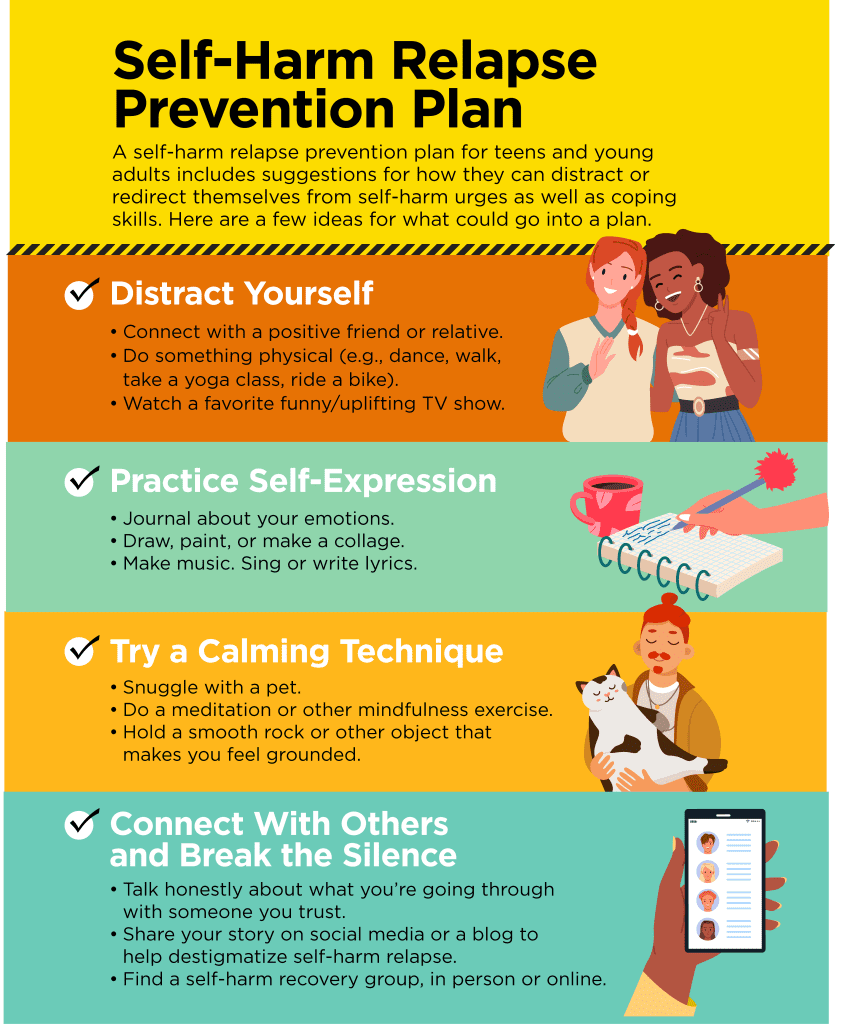Self-Harm Relapse: When Dangerous Habits Return
If a teen or young adult has experienced a self-harm relapse, it can be difficult for them — and for you, the parent who loves and wants the best for them. While this may feel discouraging, it’s important to keep in mind that with the right guidance, your child can recover
To learn more about what a self-injury relapse is, the signs of one, the types of self-harm, and how to help a teen or young adult who’s experienced a relapse, we spoke to Yurii Harden, assistant clinical director of the Embark Behavioral Health short-term residential treatment center in White Haven, Pennsylvania.
Table of contents
What Is a Self-Harm Relapse?
What does it mean to relapse in self-harm? A relapse is when a person falls back into a habit that they’ve haven’t engaged in for a period of time. It’s more common when a person is trying to make — or is experiencing — a major life change, such as breaking up with a significant other or trying to cope with their parents’ divorce.
A self-harm relapse happens when an individual begins to self-injure after a period of not harming themselves.
Types of Self-Harm
The types of self-harm can vary from person to person. In fact, according to Harden, teens and young adults can become creative with the different methods to ensure they’re discreet so friends and family are unaware of what they’re doing. This can be especially true if they’ve experienced a self-injury relapse and are ashamed.
The different types of self-harm can include:
- Cutting: Cutting, a common form of self-harm for teens and young adults, involves using sharp objects to make marks on various parts of the body. It’s not unusual for young people to cut on more than one area.
- Burning: Burning as self-harm can involve young people intentionally burning themselves with a lighter, matches, or lit cigarette. They might also keep their hands over a flame, such as one from a candle, for an extended period of time.
- Compulsive exercise: A teen or young adult may participate in compulsive exercise, which is when a person is driven to work out too much. This can lead to injury, muscle strains, or stress fractures and can interfere with relationships and social activities.
- Skin carving: Skin carving is the result of young people using a sharp object to carve words that describe how they feel about themselves or a specific situation they’re in into their skin.
- Scratching: Scratching as self-harm can involve fingernail scratches on the skin. Typically, however, the marks go deeper and are made using an object instead of fingernails.
- Hair pulling: Hair pulling as self-harm can be a response to an overly stressful situation. A person may begin pulling out hair either from their head, eyebrows, or eyelashes.
- Nail biting: Nail biting as self-harm can involve biting nails down to the bed or until they bleed. It can also look like constantly picking at the skin surrounding the nail until it bleeds.
- Hitting: Hitting as self-harm can involve a teen or young adult hitting themselves or objects around them, such as a wall, or even getting into fights often at school.
- Pinching: Pinching as self-harm involves young people constantly pinching themselves until they bruise or puncture the skin.
- Choking: Self-choking is a form of self-injury because it’s an intentional act to harm oneself. Teens or young adults may participate in self-choking if they want to feel high due to the lost and gained flow of blood and oxygen.
Signs of a Self-Harm Relapse
You can watch for several signs of a self-harm relapse in a teen or young adult. For example, you may notice they’re:
- Making unusual clothing choices, such as wearing long sleeves or pants in hot weather.
- Explaining injuries in ways that don’t make sense, such as blaming the cat for a series of cuts on their arm.
- Isolating themselves behind closed doors for long periods of time.
In addition, you may find:
- Items used for self-harm in hiding spots, such as in a jewelry box or Altoids tin, or out in the open.
- Bloody tissues in the trash can or blood stains on towels.
These signs of a self-harm relapse may indicate that something deeper, such as a mental illness or recent trauma, is coming to light.
How To Help With a Self-Harm Relapse

If your teen or young adult has experienced a self-harm relapse, remind them to treat
this as a learning experience and reassure them that they haven’t failed or started over in their recovery. Recovery takes time.
There are several ways you can provide self-harm relapse help, ranging from working with your child to identify their triggers to encouraging them to talk to a therapist.
1. Express empathy for your teen or young adult
Take time to connect with your child on an emotional level. Express empathy for what they’re experiencing. You can do this by simply saying, “I can tell you’re feeling pretty overwhelmed. I’m sorry things are so tough for you right now.”
2. Help your child identify their self-harm triggers
Identifying self-harm triggers can help your son or daughter be aware of why they’re choosing to self-harm at certain times. Harden suggested you keep an open line of communication with your teen without being too direct, as she said, “Being direct with your teen and young adult can cause feelings of being targeted and uncomfortable.”
So, for example, instead of asking your child why they hurt themself again, tell them you’d like to help them figure out the feeling and environment that gives them the urge to self-harm.
3. Encourage your teen or young adult to use coping skills
Coping skills can make self-harm urges easier to combat when they arise. By encouraging your teen or young adult to use these skills, you’re helping them find other ways to distract themselves and put space in between their thought to self-injure and the action to do so.
“I encourage teens and young adults to have multiple coping skills that can be applied to different environments and situations,” Harden said. “That way, they always have something they can practice, no matter where they find themselves. Think of it as having a toolbox of skills rather than relying on one specific approach.”
The most important coping skill for a teen or young adult who’s self-harming is one that you, the parent, develop with them: a safe relational connection between the two of you. When you create an emotionally and physically safe, empathetic, and secure relationship with your child, they can rely on that stable, meaningful relationship to help them through their relapse. Harden said this relationship will encourage their personal growth despite ups and downs; give them a sense of purpose and fulfillment; and discourage isolation and loneliness.
Additional coping skills teens and young adults can practice to address self-harm urges and prevent another self-injury relapse include mindfulness, breathing exercises, working out, and progressive muscle relaxation.
Harden also recommended young people spend quality time with positive, healthy individuals around their age who don’t engage in self-harm behaviors. This should be something socially enjoyable and out of their element so it doesn’t feel like a chore.
4. Work with your child to create a self-harm relapse prevention plan

A self-harm relapse prevention plan can provide teens and young adults with instruction for when they feel the urge to self-harm. Harden suggested revisiting the plan weekly or monthly so it remains effective since it may need to be updated from time to time.
A self-harm relapse plan should include suggestions for distracting or redirecting your son or daughter’s mind from self-harm urges; coping skills to be used in different environments, such as at school, at home, or with friends; and a list of support people, along with a description of what each person can do for them when they’re in a crisis.
5. Reach out to a therapist
When it comes to what to do after a self-harm relapse, if you believe your child may need more assistance, encourage them to start speaking with a therapist or to contact their therapist if they already have one. Harden said you should encourage your teen or young adult to contact a therapist themselves. If you reach out without their knowledge, that could cause them to feel alienated from you.
Exceptions would be if you suspect your child’s safety is at risk, there are threats of suicide, or they’re experiencing any kind of psychosis, such as hearing or seeing things they perceive as being real and aren’t or receiving command hallucinations, such as “Cut yourself deeper this time.”
Self-Harm Relapse: Wrapup
When young people start self-injuring again, it can be difficult for them — and you, the parent. However, by knowing how to help your teen or young adult, which includes expressing empathy, encouraging use of coping skills, and contacting a therapist if needed, you can help them along the road to recovery after a self-harm relapse.
“During a relapse, supporting and intervening with a calm and tolerant presence increases the likelihood of a collaborative positive outcome,” Harden said. “Healthy, safe communication is the key.”
Embark is the most trusted name in teen and young adult mental health treatment. We’re driven to find the help your family needs. If you’re looking for support, contact us today!
